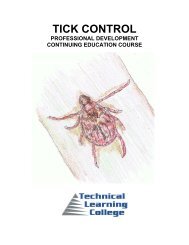INVASIVE PLANTS - Technical Learning College
INVASIVE PLANTS - Technical Learning College
INVASIVE PLANTS - Technical Learning College
Create successful ePaper yourself
Turn your PDF publications into a flip-book with our unique Google optimized e-Paper software.
Russian thistle was introduced from Russia and is an annual which reproduces by seed. It is a<br />
round, bushy, much-branched plant, growing 1 to 3-1/2 feet high. The branches are slender,<br />
succulent when young, and woody when mature. Russian thistle grows on dry plains, in<br />
cultivated fields, roadsides, and waste places, chiefly in grain-growing areas. At maturity, the<br />
plant breaks off at the base and because of its round shape, becomes an excellent<br />
tumbleweed. Russian thistle is an annual. A single plant may produce 20,000 to 50,000 seeds.<br />
Seeds germinate quickly, even after brief or limited precipitation. The plants are well branched,<br />
round bushy that grow 1/2 to 3 feet high. The stems have reddish or purple strips. The leaves are<br />
alternate, long, and very thin or needle-like. Flowers are small and inconspicuous and develop in<br />
the upper leaf axils. Each flower has a pair of spiny bracts. Mature plants break off at ground level<br />
and tumble, spreading the seeds. This species is a host of sugar beet leafhopper, which transmits<br />
curly top of sugar beets. This weed is common in drier areas and in dry land cultivation systems.<br />
It is found in overgrazed rangeland, disturbed waste areas and in wheat, sugar beet, potato, and<br />
mint crops east of the Cascade Mountains.<br />
Control Control of Russian thistle is difficult. There have been numerous attempts through the years<br />
to import biological control agents, but none have been successful.<br />
Pre-emergent herbicides are applied to the soil before the weed seed germinates and are<br />
usually incorporated into the soil with irrigation or rainfall. The most effective pre-emergent<br />
herbicides are Aatrex (atrazine), Velpar (hexazinone), Devrinol (napropamide), Telar<br />
(chlorsulfuron), Oust (sulfometuron), Princep (simazine) and Hyvar (bromacil). Other preemergent<br />
herbicides that are registered but only moderately effective in controlling Russian thistle<br />
are Surflan (oryzalin), Treflan (trifluralin), Prowl (pendimethalin), Endurance (prodiamine), Lasso<br />
(alachlor), Predict (norflurazon), and Kerb (pronamide).<br />
Herbicide-resistant biotypes of Russian thistle have evolved in only a couple of years following<br />
treatment with Telar (chlorsulfuron) or Oust (sulfometuron). Avoid repeated use of a single<br />
herbicide or of herbicides that have the same mode of action to prevent the evolution of<br />
herbicide-resistant populations.<br />
Post-emergent herbicides are applied to plants, but timing is critical. For best results, these<br />
herbicides must be applied while the weed is in its early growth stages, preferably the early<br />
seedling stage, before it becomes hardened and starts producing its spiney branches. Do not use<br />
post-emergent herbicides to try to control the mature seed (either on the plant or on the ground)<br />
as they are not effective for this purpose. Also, the later spiney stage of Russian thistle is not<br />
readily controlled by any post-emergent herbicide. If rain or irrigation occurs after a postemergent<br />
application, additional seedlings may emerge and require future treatments. Postemergent<br />
herbicides that are effective when properly applied include Banvel or Vanquish<br />
(dicamba), Roundup (glyphosate), 2,4-D and Gramoxone (paraquat).<br />
Milkweed plants, members of the Asclepias family, are the only host plant for the monarch and<br />
queen butterflies. The adult females seek out these plants on which they lay their eggs. The<br />
caterpillars that hatch will remain on the plants and eat the leaves until they enter the pupal stage,<br />
then emerge as adult butterflies. It is a perennial herb with long-spreading rhizomes. Stems are<br />
stout, erect, to 2 m tall, with short downy hairs and milky juice; leaves opposite, oblong, rounded,<br />
1–2.6 dm long, 0.4–1.8 dm broad, with prominent veins; upper surface smooth, lower covered<br />
with short white hairs and strong transverse nerves. Flowers sweet-smelling, pink to white, in<br />
large, many-flowered, axillary and apical bell-like clusters; corolla lobes 6–9 mm long, hoods 3–4<br />
mm high; follicle grayish, hairy, with soft spiny projections, 1–3 mm high, slenderly ovoid, 2.5– 3.5<br />
cm thick. Seed brown, flat, oval, 6 mm long, 5 mm wide, with a tuft of silky white hairs apically<br />
(Reed, 1970)<br />
Control Non-Cropland -- Established stands of common milkweed can be controlled with<br />
herbicides. On non-cropland (i.e., roadsides, railroad rights-of-way, etc., but not idle land or<br />
grazing land), Amitrol-T, Roundup or Tordon would provide control. Herbicide coverage of the<br />
common milkweed is incomplete with this method, resulting in reduced effectiveness compared to<br />
a sprayer. Used over several years, however, common milkweed populations can be reduced<br />
with Roundup applied in a wiper applicator. Controls: Amino Trizole; Amitrol-T, Roundup, 2,4-<br />
D+Banvel,and Tordon<br />
Invasive Plants 11/13/2011 36<br />
WWW.ABCTLC.COM

















